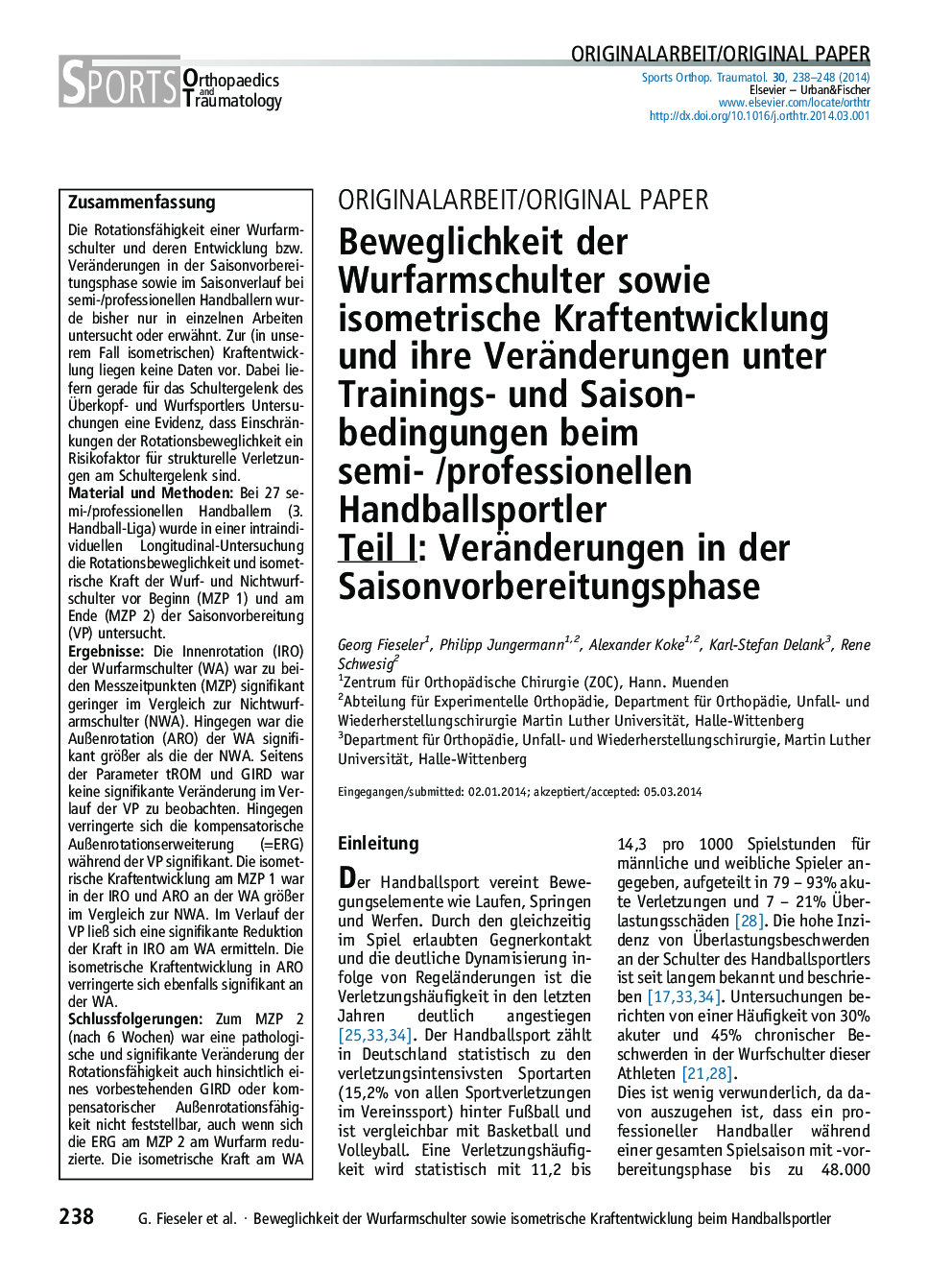| Article ID | Journal | Published Year | Pages | File Type |
|---|---|---|---|---|
| 2740293 | Sports Orthopaedics and Traumatology | 2014 | 11 Pages |
ZusammenfassungDie Rotationsfähigkeit einer Wurfarmschulter und deren Entwicklung bzw. Veränderungen in der Saisonvorbereitungsphase sowie im Saisonverlauf bei semi-/professionellen Handballern wurde bisher nur in einzelnen Arbeiten untersucht oder erwähnt. Zur (in unserem Fall isometrischen) Kraftentwicklung liegen keine Daten vor. Dabei liefern gerade für das Schultergelenk des Überkopf- und Wurfsportlers Untersuchungen eine Evidenz, dass Einschränkungen der Rotationsbeweglichkeit ein Risikofaktor für strukturelle Verletzungen am Schultergelenk sind.Material und MethodenBei 27 semi-/professionellen Handballern (3. Handball-Liga) wurde in einer intraindividuellen Longitudinal-Untersuchung die Rotationsbeweglichkeit und isometrische Kraft der Wurf- und Nichtwurfschulter vor Beginn (MZP 1) und am Ende (MZP 2) der Saisonvorbereitung (VP) untersucht.ErgebnisseDie Innenrotation (IRO) der Wurfarmschulter (WA) war zu beiden Messzeitpunkten (MZP) signifikant geringer im Vergleich zur Nichtwurfarmschulter (NWA). Hingegen war die Außenrotation (ARO) der WA signifikant größer als die der NWA. Seitens der Parameter tROM und GIRD war keine signifikante Veränderung im Verlauf der VP zu beobachten. Hingegen verringerte sich die kompensatorische Außenrotationserweiterung (=ERG) während der VP signifikant. Die isometrische Kraftentwicklung am MZP 1 war in der IRO und ARO an der WA größer im Vergleich zur NWA. Im Verlauf der VP ließ sich eine signifikante Reduktion der Kraft in IRO am WA ermitteln. Die isometrische Kraftentwicklung in ARO verringerte sich ebenfalls signifikant an der WA.SchlussfolgerungenZum MZP 2 (nach 6 Wochen) war eine pathologische und signifikante Veränderung der Rotationsfähigkeit auch hinsichtlich eines vorbestehenden GIRD oder kompensatorischer Außenrotationsfähigkeit nicht feststellbar, auch wenn sich die ERG am MZP 2 am Wurfarm reduzierte. Die isometrische Kraft am WA war in der IRO zum MZP 2 signifikant reduziert. Alle Veränderungen deuten eher auf Adaptations-/Belastungsprozesse des Schultergelenkes im Rahmen der Trainingsbelastungen hin.EvidenzebeneLevel III.
The rotational capacity of the throwing shoulder and their changes during the pre-season and season in semi- and professional team handball athletes is not very much investigated yet. There are no data on changes in isometric strength as well, but correlations between the overhead- and throwing athlete shoulder, their changes in the rotational capacity and a risk of structural joint damages and symptoms.Materials and MethodsIn a longitudinal intra-individual investigation 27 semi- and professional male, third league team handball athletes underwent a specific clinical shoulder examination and were examined at the beginning (MZP 1) and end (MZP 2) of the pre-seasonal training (VP) at the dominant (throwing) and non dominant (non throwing) shoulder according to rotational strength (isometric) and range of motion.ResultsThe internal rotation (IR) at the dominant throwing shoulder (WA) was significantly reduced in comparison to the non throwing shoulder (NWA) at both days of determinations (baseline, after 6 weeks). The external rotation (ER) at the WA was significantly greater than the ER at the NWA at both times. The total range of motion (tROM) and the GIRD was slightly, but not significantly reduced at the WA at the end of the VP. The external rotational gain (ERG) was significantly reduced during the VP. The isometric strength in IR and ER at the WA was larger in comparison to the NWA at baseline. During the VP a significant reduction in internal rotational (IR) and isometric strength was seen at the WA. The external rotational isometric strength (ER) significantly reduced as well over the period of time at the WA.ConclusionsOver the period of 6 weeks the pre-seasonal training in team handball did not lead to significant pathological changes of the rotational capacities in shoulder joints, even not in a glenohumeral internal rotation deficit. The external rotation gain did significantly reduce after the period of the pre-seasonal training. The isometric strength in internal and external rotational movement also decreased significantly. Our data more likely show adaptive processes at the throwing shoulder joint according to the workload during training.Level of EvidenceLevel III.
